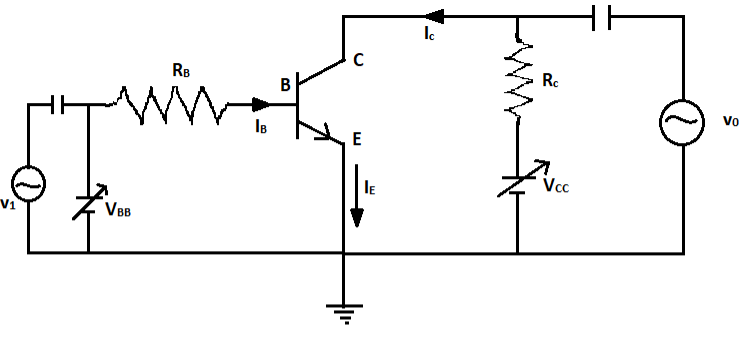
Draw a circuit diagram of a transistor amplifier in CE configuration.
Define the terms:
(i) Input resistance and
(ii) Current amplification factor.
How are these determined using typical input and output characteristics?
Answer
564.3k+ views
Hint: Recall the common emitter configuration of a transistor amplifier. Also recall its circuit diagram, its V-I characteristics graph. Always remember, in common emitter configuration, the input current and the output voltage are taken as the independent variables, whereas the input voltage and output current are the dependent variables.
Complete step by step solution:
The circuit diagram of a transistor amplifier in Common-Emitter configuration is given by,

(i) Input resistance :- It is defined as the ratio of change in base-emitter voltage to the change in base current at constant ${V_{CE}}$ . The change in base-emitter voltage that is $\Delta {V_{BE}}$ and the change in base current that is $\Delta {I_B}$ can be calculated from the input characteristics of the transistor amplifier in CE configuration.
Mathematically, Input resistance is defined by,
${R_{iB}} = \left( {\dfrac{{\Delta {V_{BE}}}}{{\Delta {I_B}}}} \right)$ at constant ${V_{CE}}$
Where, $\Delta {V_{BE}}$ is the change in base-emitter voltage
$\Delta {I_B}$ is the change in the base current
${V_{CE}}$ is the collector-emitter voltage
For finding the input resistance, we have to mark a point P on the input characteristics and then draw a tangent at point P and then the reciprocal of slope AB will give us the input resistance.
(ii) Current amplification factor :- It is defined as the ratio of the change in collector current to the change in the base current taking collector voltage constant. It is denoted by $\beta $
Mathematically, current amplification factor is defined by,
$\beta = \left( {\dfrac{{\Delta {I_C}}}{{\Delta {I_B}}}} \right)$ at constant $V_{CB}$.
Where, \[\Delta {I_C}\] is the change in collector current.
$\Delta {I_B}$ is the change in the base current.
The value of current amplification factor is obtained from the Output characteristic graph that is $I_C$ versus $V_{CE}$ plot by using different values of $I_B$.
Note: The common-emitter configuration provides good current gain and voltage gain. As the input resistance is of very low value, a small value of $\Delta {V_{BE}}$ is enough to produce a large current flow of the base current. The current gain in Common Emitter connection is very high. This is the reason this circuit connection is mostly used in all transistor applications.
Complete step by step solution:
The circuit diagram of a transistor amplifier in Common-Emitter configuration is given by,

(i) Input resistance :- It is defined as the ratio of change in base-emitter voltage to the change in base current at constant ${V_{CE}}$ . The change in base-emitter voltage that is $\Delta {V_{BE}}$ and the change in base current that is $\Delta {I_B}$ can be calculated from the input characteristics of the transistor amplifier in CE configuration.
Mathematically, Input resistance is defined by,
${R_{iB}} = \left( {\dfrac{{\Delta {V_{BE}}}}{{\Delta {I_B}}}} \right)$ at constant ${V_{CE}}$
Where, $\Delta {V_{BE}}$ is the change in base-emitter voltage
$\Delta {I_B}$ is the change in the base current
${V_{CE}}$ is the collector-emitter voltage
For finding the input resistance, we have to mark a point P on the input characteristics and then draw a tangent at point P and then the reciprocal of slope AB will give us the input resistance.
(ii) Current amplification factor :- It is defined as the ratio of the change in collector current to the change in the base current taking collector voltage constant. It is denoted by $\beta $
Mathematically, current amplification factor is defined by,
$\beta = \left( {\dfrac{{\Delta {I_C}}}{{\Delta {I_B}}}} \right)$ at constant $V_{CB}$.
Where, \[\Delta {I_C}\] is the change in collector current.
$\Delta {I_B}$ is the change in the base current.
The value of current amplification factor is obtained from the Output characteristic graph that is $I_C$ versus $V_{CE}$ plot by using different values of $I_B$.
Note: The common-emitter configuration provides good current gain and voltage gain. As the input resistance is of very low value, a small value of $\Delta {V_{BE}}$ is enough to produce a large current flow of the base current. The current gain in Common Emitter connection is very high. This is the reason this circuit connection is mostly used in all transistor applications.
Recently Updated Pages
A man running at a speed 5 ms is viewed in the side class 12 physics CBSE

The number of solutions in x in 02pi for which sqrt class 12 maths CBSE

State and explain Hardy Weinbergs Principle class 12 biology CBSE

Write any two methods of preparation of phenol Give class 12 chemistry CBSE

Which of the following statements is wrong a Amnion class 12 biology CBSE

Differentiate between action potential and resting class 12 biology CBSE

Trending doubts
What are the major means of transport Explain each class 12 social science CBSE

Which are the Top 10 Largest Countries of the World?

Draw a labelled sketch of the human eye class 12 physics CBSE

Explain sex determination in humans with line diag class 12 biology CBSE

Explain sex determination in humans with the help of class 12 biology CBSE

Differentiate between homogeneous and heterogeneous class 12 chemistry CBSE




